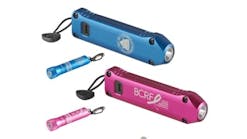Good Practices in Fluorescent Penetrant Inspection
By Fred Workley
March 2000
Fred Workley is the president of Workley Aircraft and Maintenance Inc. in Manassas, VA. He is on the technical committees of PAMA and NATA and participates in several Aviation Rulemaking Advisory Committees. He holds an A&P certificate with an inspection authorization, general radio telephone license, a technician plus license, ATP, FE, CFI-I, and advance and instrument ground inspector licenses.
When I started reading
one of the FAA reports published in August 1999, I thought I already knew all about fluorescent penetrant inspection. However, there is new information that I would like to pass on to you.
The Federal Aviation Administration Office of Aviation Medicine issued a report prepared by Colin G. Drury under contract with the FAA titled, Human Factors: Good Practices in Fluorescent Penetrant Inspection. It reviews research that looks at accumulated knowledge of human factors engineering as applied to Nondestructive Inspection (NDI) of critical rotating engine components.
The report points out that good results from fluorescent penetrant inspection (FPI), using liquid penetrant, depends on Procedures, Materials, and Human Factors. Because of the visual nature of liquid penetrant, it is dependent on human performance which includes skill, cognitive ability, and attitude. The report offers 86 best practices that impact probability of detection, as well as reliability, technical, environmental, and organizational issues. Let's look at some of the report's conclusions.
FPI relies on good procedures. Your success depends on the penetrant getting into the crack, which is a capillary opening. It's a good idea to review the new Advisory Circular, AC 43.13-1B, Acceptable Methods, Techniques, and Practices — Aircraft Inspection and Repair, dated 9/8/98. Section 5, Penetrant Inspection, Table 5-4 shows a general process.
The first procedure is to clean the component thoroughly with materials that are compatible with the system you are using. After the component is dry, you apply the penetrant. There will be a recommended "dwell" time to permit the penetration into the capillary opening. Next, remove the surface penetrant fluid without removing fluid from the capillary. Then, apply a developer to draw the penetrant from the capillary to the surface. You are looking for the visual contrast to indicate a crack. Now comes the tough part.
Visual inspection will detect the presence of a crack, but you will now have to classify and interpret type, size, and suitability for service of the part. Ask yourself if airworthiness is affected. The magnitude of the crack may or may not be a cause for rejection under the suitable inspection criteria. In order to make these determinations, some procedures may require the use of 5X or 10X magnifying loupe that can be used hands-free. One solution is flip down magnifiers that can be attached to safety glasses. Follow published procedures carefully for best results.
Procedures generally follow these steps: Initiation, Access, Search, Decision, and Response.
Initiation consists of all processes, including cleaning, that lead up to the actual visual inspection. You need to get and understand the applicable work instructions. Check the part to determine that it matches the paperwork. Prepare the inspection tools and adjust the booth lighting so that your eyes adapt to your environment.
Access requires proper positioning of the component as needed throughout the inspection as specified by the inspection system.
The Search begins by visually scanning the component to confirm adequate cleaning. Scanning in sections or areas, back and forth, increases your chance of finding defects, thus increasing the probability of detection.
The Decision function is your chance to compare the crack with known standards. This is when re-testing may be necessary by re-bleeding. Confirmation may be required using a magnifying loupe or a white light.
Your Response may be the confirmation of the crack and marking for later disposition or repair. There are two possibilities: non-conforming action taken on a conforming article, or conforming action taking on a non-conforming article. The type of materials used, along with surface condition and cleaning, impact the results.
It is important to remember that any process that modifies the components surface must not be applied prior to the FPI. Mechanical processes like sanding and sand-blasting will close the capillary opening and "smear" the surface. Only etching or neutralization steps will then open up the capillary. Other processes that may impact the inspection are anodizing, plating, painting, conversion coatings, and shot peening. All mechanical removal processes result in a decrease in penetrant detection. You may have to consult engineering assistance regarding etching after any machining of "hard materials."
Great care must also be taken to prevent metal-to-metal contact, particularly with critical rotating engine parts. This may require an analysis, possibly by making a list, of all possible ways metal-to-metal contact could occur. Parts should not be removed from shipping containers or from parts carriers unless they are in process. Leave protective coatings or wrappings on parts to prevent scratches during shipment and storage. Any contact by the component by a metal object may induce errors in the FPI findings. These precautions need to be taken whether the component surface is either considered soft or hard.
There are new considerations for the re-testing of crack indications. This re-testing may be necessary to confirm the extent of damage after a part has been removed for better access. Solvents used for re-bleeding indications have changed in response to environmental concerns. These new chemicals have introduced a large potential error into the visual search process.
When the re-testing is performed by swabbing the capillary with solvent, it is important that the inspector wait for the solvent to dry completely. Drying time, as specified on the solvent labels, may be many minutes, but the solvent in the capillary may not be dry. This may require application of heat or drying air. It may be necessary to mark the general area of the crack so that it can be easily found after an extended drying time. In other words, the replacement solvents are generally very slow-acting even though they are environmentally-friendly.
This new problem applies also to both aqueous and non-aqueous wet developer (NAD) although the more rapid-acting, environmentally-friendly NADs generally are not available. The necessary time delays could introduce some errors. Please remember to take all necessary precautions when using hazardous materials. Spray guns and dispenser cans should have approved hazardous materials stickers. Handwritten labels are not acceptable.
Again, AC 43.13-1B has some helpful tables. Table 5-3 shows the classification of penetrant inspection materials by MIL-I-25135E. Table 5-5 outlines pre-cleaning methods for penetrant inspection. Table 5-6 lists commonly accepted standards and specifications for penetrant inspection.
In the past, studies of human factors seemed to take the view that inspection is an error-prone activity. I don't think that is the view today. Inspection is now a very deliberate and exacting activity, which has become very reliable through emphasis on human factors. We have been helped by improved inspection techniques and job aids.
We have applied statistical controls through vigilance and detection theory. We have modeled the inspection tasks.
An example would be in the Search phase. The inspector functions as a low-level detector of indications, but with a high cognitive input by choosing and modifying the scan pattern. Humans are uniquely adaptable to self-reprogramming in order to achieve the desired results. The results being a determination whether or not a discrepancy exists. In the past, it was thought that this adaptability lead to possible errors. I look at this flexibility as an opportunity that can be used to enhance your value as an inspector.
You alone are responsible for improving decision making while reducing decision errors. This is where your attitude as a professional is important. I once authorized double overtime for an inspector to complete a particular job. I was later criticized. It was said that "It was a lot of money wasted when the inspector didn't find anything." My response was that it was worth a lot to the company to confirm that that particular aircraft could fly safely for another 500 hours.
It's okay not to find anything if nothing is there to find. In his report, Drury supports this by saying "Unfortunately, evidence for inspection decrements is largely negative." What this means to me is that if you don't pay attention, you can miss something.
When we look at broad human factors control mechanisms, we the humans are the variables. We have to follow procedures and adjust for materials issues.
Finally, a key element is training. Classroom training on FPI, when supplemented with on-the-job training, serves the foundation of our knowledge and skills.
These issues are covered in depth in Drury's August 1999 report. You can find The Human Factors Guide for Aviation Maintenance at the web site: www.hfskyway.com.





